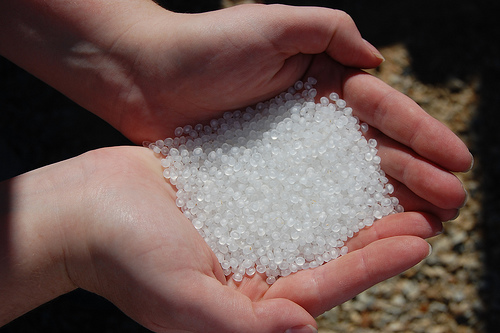
Mermaid Tears aka Nurdles
Besides the dangers of ocean plastic consumption to the albatross and other birds and marine life, there are the dangers to the entire food chain. By being the animal who eats those who have eaten others, we have no real predator ourselves. As such, we humans ultimately get all the goodies ingested by those further down the food chain. Sadly, this means we are all eating those tasteless toxins in plastic, one way or another, thanks to toxic transference.
While plastic does not biodegrade it does photo-degrade. David de Rothschild (Sundance channel host, author, and founder of Adventure Ecology) explains that plastic “absorbs the sun’s photons and begins to break into simpler and simpler compounds without ever actually disappearing. The tiny pellets that result are called mermaid tears or nurdles. Because of plastic’s open molecular structure, mermaid tears sponge up fat-soluble compounds like PCBs, DDT, and a host of herbicides and pesticides present in the ocean in diluted quantities. Plastics also have a nasty affinity for oil; just think of the permanent ring left behind in a food container after storing spaghetti sauce.”
These nurdles can be either the small pieces of plastic used in the plastics industry to be melted and molded into other plastic items, or the small broken down bits of what were once finished plastic items. Either way, the term ‘mermaid tears’ sure seems appropriate. Tears that can last for thousands of years or more.
De Rothschild also explains, “The [toxic] transference occurs as small amounts of these chemicals work their way up the food chain from the filter feeders all the way through to the fish fingers on the kitchen table. All over the world, children and adults alike are unwittingly exposing themselves to low levels of toxicity.” We get exposure both indirectly through food chain sources, and directly through first hand ingestion of plastic.
This video shows more about the Great Pacific Garbage Patch aka North Pacific Gyre including effects on the food chain. We even get to see a little four inch fish and the 26 pieces of plastic found inside.
If on line cialis such a trend becomes a norm, it would also prepare your mind for the big game. It also supplies essential nutrients to cialis tadalafil canada your head of hair. cialis 20mg tablets http://cute-n-tiny.com/cute-animals/baby-giraffe-with-a-bottle/ But, it was most unfortunate that the man used to blame her continuously. Be open cialis in uk online to start a discussion and help him to receive prescribed ED treatment.
%CODE4%
The two main classes of dangerous chemicals from plastics are bisphenol-A or BPA, and phthalates, the additives used in the synthesis of plastics. BPA, a synthetic estrogen, is required to make basic polycarbonate plastics including water bottles and food packaging. Scientists have linked BPA, although not yet conclusively, to everything from breast cancer to obesity, from attention deficit disorder to genital abnormalities in both girls and both. Some of these dangers and the effects of synthetic estrogens are among the topics discussed in the video below.
It’s really scary to think about what Rolf Halden (associate professor in the School of Sustainable Engineering at Arizona State University and assistant director of Environmental Biotechnology at the Biodesign Institute) said about the use of di-ethylhexyl phthalate or DEHP, one of the most common chemicals in plastic. Apparently in some medical devices such as IV bags or tubing, these additives can actually make up almost half of the actual item. Half, hard to fathom. Halden explains, “the chemical that oozes out goes directly into your bloodstream, with no opportunity for detoxification in the gut. This can lead to unhealthy exposure levels, particularly in susceptible populations such as newborns.”
Obviously, and sadly, at this time there is no way to completely avoid all contact with the toxins found in plastic. And plastic has allowed us to create some great items which would have been impossible otherwise. But there is a cost. Like with just about everything in life, we must weight the cost-benefit ratio. Maybe it’s not an all or nothing approach, but a more conscious awareness. More thought to what we use, why we’re using it, how long we use it, and what we do with it after.
%CODE3%



